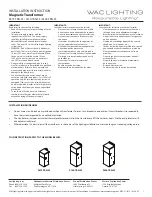
J8
J8
Interconnecting media
Vcc 1
Vcc 2
Input
Pattern to
Driver
J4
D
J9
A
B
P 3
P 1
EVM #1
EVM #2
Power Supply
No
. 1
P 3
GND 1
GND 2
Vcc 1
Vcc 2
P 3
P 1
Power Supply
No
. 2
GND 1
GND 2
A
B
J9
Power Supply
No
. 3
R
Output from
Receiver
Recommended Equipment
www.ti.com
Figure 9. EVM Configuration for Inducing a Ground Potential Difference Voltage Between Nodes
2
Recommended Equipment
•
5-Vdc at 0.5 A power supply
•
A pattern generator capable of supplying single-ended signals at the desired signaling rate and input
levels
•
A multiple-channel, high-bandwidth oscilloscope, preferably above the 100-MHz range. Differential and
single-ended oscilloscope probes
•
When using two or more EVMs, a 100-
Ω
transmission medium between transceivers (twisted-pair
cable recommended, CAT5 cable for example) made be used using JMP7 and JMP9 (half duplex)
between EVMs. Full-duplex connections can be made using JMP5/JMP7 and JMP8/JMP9. The
termination resistors need to be configured for each case.
2.1
EVM Configurations
The schematic for the ISO1176TEVM appears on the last page of this manual.
Table 1
contains a list of the onboard jumpers and their function as well as the input and output loading
installed on the board for the half-duplex ISO1176TEVM.
Table 2
contains the same information for the
full-duplex ISO35TEVM and ISO3086TEVM.
Table 1. EVM Configuration Options for ISO1176T
Jumper Function
Configuration
I/O Load
DATA/CONTROL
SIDE JUMPERS
JMP1 – Receiver Output
R1 (see JMP16)
JMP2 – Receiver Enable
R2 – 50
Ω
(1)
JMP3 – Driver Enable
R3 – 50
Ω
(1)
JMP4 – Driver Input
R4 – 50
Ω
(1)
R7 – Uninstalled
JMP6 – D1/D2 Test Point
R8 – Uninstalled
JMP16 – Rout Load
Jumper short allows Rout to be
pulled up to Vcc or to GND through
R10 – Uninstalled
a 1-k
Ω
resistor.
(1)
These resistors are provided as impedance-matching terminations to be used when driving these
signals with 50-
Ω
source impedance test/measurement equipment. When not driving these signals with
a 50-
Ω
source, the components must be removed.
8
ISO1176T/35T/3086T Evaluation Module
SLLU122A – April 2010 – Revised July 2010
Copyright © 2010, Texas Instruments Incorporated




































